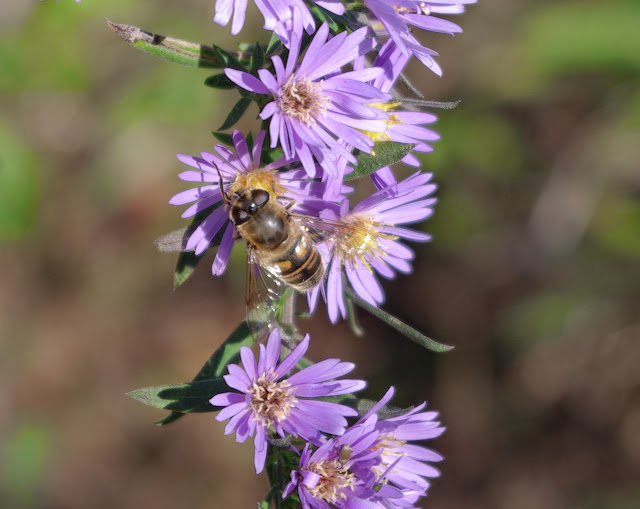The northern side of our property is bordered by Middle Creek, which joins Swift Creek shortly before emptying into the Neuse River near Smithfield, NC. The Neuse River has a large watershed in eastern North Carolina and eventually ends up at the Pamlico Sound. Here Middle Creek is about 40-50 feet wide, but after a major rain event it spreads out in an area 3/8s of a mile wide and covers much of the farm. Its headwaters are in the next county over, so I keep an eye on how much rain southwestern Wake County gets too.
This is a view on November 5th at the end of a trail that winds down to the creek, looking downstream. The tree laying across the creek is a big cherrybark oak that went down when Hurricane Floyd passed through.
We have had a rather dry year but not terribly droughty, so I was surprised to see the slough next to the trail and adjacent to the stream dry like this. This slough was created years ago by beavers and is populated by water tupelo (a beautiful red bright in the fall some years), red maples, willows and
Hibiscus moscheutos. We frequently see turtles and wood ducks when the slough is full, which is most of the time. Prothonotary warblers, one of the most fearless of wild birds, like the slough too. I used to see prothonotary warblers at Jordan Lake when we went birding there and was delighted to see them here. Beavers are still active in the creek and we've had to dismantle a few of their engineering projects. I've even seen one and was rather surprised by its size.
This is the slough in April '08, filled with water.

While the Neuse River has been plagued by pollution problems and frequently looks muddy in Smithfield, Middle Creek is clean, not just by my estimation but by state water testing. Still, I was surprised by the clarity of the water. Perhaps the economic slowdown has halted development upstream.
A lot of musclewood (Carpinus caroliniana) grows in the floodplain here. You can see how it gets its name, how the fine barks looks like skin over rippling muscles. It's also known as ironwood. According to
Gardening with Native Plants of the South, "The wood is so fine-grained and strong that it was once highly prized as timber for house foundations". Other common names include American hornbeam, blue beech and water beech. This is one of my favorite falls trees, especially in the fall. Its fall color was beautiful this year (but that's another post!).
This late in the year all I could find were the golden seedheads of Northern river oats (they cover the banks in some places) and this frost aster, but there are a lot of wildflowers by the creek during the year: marsh violets, hawthornes and wild crabapples in spring, and wild hibiscus, Joe Pye Weed, white turtlehead, Bidens, and wild Ageratum in summer and fall. In the floodway fields and sloughs that empty into the creek there are even more native flowering plants:
Geranium maculatum,
Amsonia tabernaemontana, lyreleaf sage, spreading bellwort, atamasco lily, Jack-in-the-pulpit, Jessamine, serviceberry, fringetree, American snowbell, highbush blueberry, Barbara's buttons, Virginia sweetspire, viburnums,
Scutellaria incana, a species of Sabatia, elderberry, sweetbay (
Magnolia virginiana) coastal pepperbush, swamp cyrilla, swamp azalea, turk's cap lily, downy lobelia, cardinal flower, gerardia (although I cannot find any this year, darn it!), Boltonia, several species of goldenrod, green coneflower, soapwort gentian, and hearts-a-burstin' (if the deer don't eat them before they can fruit). In addition to Northern river oats, sugarcane plumegrass is a very striking grass, and even broomsedge and teddy-bear paws (
Scirpus cyperinus) has won me over.
We've had at least 7" of rain since I took these pictures, so I imagine the slough has water in it now!





















































